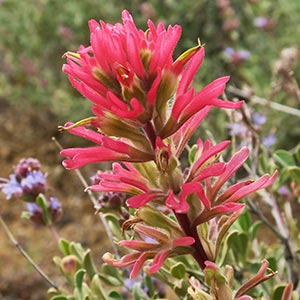Castilleja angustifolia
Castilleja aquariensis
narrow-leaf paintbrush, northwestern Indian paintbrush, northwestern paintbrush, violet desert paintbrush
Aquarius paintbrush, Aquarius Plateau Indian paintbrush, Aquarius Plateau paintbrush
few to many, ascending to erect, branched, especially near base, sometimes unbranched, hairs sparse to dense, spreading to retrorse, long, sometimes short, soft to stiff, usually mixed with short-glandular ones, sometimes viscid.
few to several, ascending to erect, unbranched, hairs moderately dense, often retrorse, short, ± stiff, stipitate-glandular distally only in inflorescence.
brown or purplish, sometimes green, linear to lanceolate or broadly lanceolate, 1.2–7(–7.5) cm, not fleshy, margins plane, sometimes ± wavy, involute or flat, (0–)3–5-lobed, rarely with secondary lobes, apex acuminate to rounded;
lobes spreading, oblong or lanceolate to linear-lanceolate, apex acute to rounded.
appressed-ascending, green to purplish, linear to narrowly lanceolate, distal sometimes broadly lanceolate, (1–)2.5–4(–5.5) cm, not fleshy, margins plane, involute, 0(–5)-lobed, apex rounded to acuminate;
lobes ascending, linear to narrowly lanceolate, apex acute.
2.5–20 × 1.5–5 cm;
bracts proximally greenish or dull purplish, distally pink, magenta, pink-purple, reddish pink, pale yellow, pale yellow-orange, pale orange, or white, rarely reddish or orange-red, lanceolate to oblong, 3–5(–9)-lobed, sometimes with secondary lobes;
lobes spreading or ascending, oblanceolate or linear, proximal lobes often much longer than distal, proximal lobes arising below or a little above mid length, apex acute to rounded.
2–7 × 1.5–2 cm;
bracts proximally pale green to pale yellow-green, distally pale to bright yellow or cream, rarely pale orange, elliptic, narrowly ovate, elliptic-oblong, broadly lanceolate, or ovate, (0–)3(–5)-lobed;
lobes ascending or spreading, narrowly lanceolate, short, arising near tip on distal bracts, central lobe apex rounded to truncate, lateral ones acute to rounded.
straight, 18–27(–32) mm;
tube 8–17 mm;
beak usually long-exserted, adaxially green or pink, 8–15 mm;
abaxial lip deep green, reduced, inconspicuous, 1–2.5 mm, 5–20% as long as beak;
teeth incurved to ascending, deep green, 0.5–1.5 mm.
straight, 17–25 mm;
tube 9–13 mm;
beak exserted, adaxially green, 6–8(–12) mm, margins red or reddish brown, short-hairy;
abaxial lip green, reduced, sometimes exserted, 1.5–2 mm, 10–15% as long as beak, glabrous;
teeth erect, green, 0.5–1.5 mm.
proximally green, yellow, brown, or purple, lobes colored as bract lobes, sometimes with a yellow band between proximal and distal parts, 13–25(–28) mm;
abaxial clefts 3–8 mm, adaxial 5–9(–12) mm, clefts 30–50% of calyx length, deeper than laterals, lateral (1–)1.5–4(–5) mm, 10–25% of calyx length;
lobes lanceolate to oblong, abaxials wider than adaxials, apex acute to rounded.
proximally green to yellowish, distal 1/2 yellow, (16–)18–25 mm;
abaxial and adaxial clefts (8–)9.5–12.5 mm, 50% of calyx length, deeper than laterals, lateral 0.5–5(–6) mm, 5–20% of calyx length;
lobes lanceolate to ovate, apex acute to obtuse.
Castilleja angustifolia
Castilleja aquariensis
Varieties 3 (3 in the flora).
Much confusion exists concerning Castilleja angustifolia and the closely related C. chromosa. Sometimes C. chromosa is treated as a variety of C. angustifolia, using the name C. angustifolia var. dubia. The latter name is used here to represent a different assemblage of plants, not including C. chromosa. At other times, C. chromosa is synonymized completely under C. angustifolia. However, the two species are in most cases easily separable, and where they are sympatric there is little evidence of intergradation. Both C. angustifolia var. dubia and C. chromosa are accepted here. See additional comments under 3b. C. angustifolia var. dubia and 15. C. chromosa.
(Discussion copyrighted by Flora of North America; reprinted with permission.)
Castilleja aquariensis is endemic to the Aquarius Plateau in the mountains of south-central Utah. Its meadow habitats were severely degraded by livestock grazing, and at one time the species was a candidate for listing under the Endangered Species Act of the United States. It is still a species of management concern.
Castilleja aquariensis is in the Center for Plant Conservation’s National Collection of Endangered Plants.
(Discussion copyrighted by Flora of North America; reprinted with permission.)
1. Bracts distally usually pink to pink-purple; s Idaho, sw Montana, se Oregon, nw Wyoming. | var. angustifolia |
1. Bracts distally yellow, yellow-orange, pale orange, white, pink, reddish pink, or magenta; se Idaho, e Nevada, sw South Dakota, w Utah, ec Wyoming. | → 2 |
2. Bracts distally usually yellow to pale orange or white; ec Wyoming, adjacent sw South Dakota. | var. dubia |
2. Bracts distally usually yellow, yellow-orange, white, pink, or reddish pink; se Idaho, e Nevada, w Utah. | var. flavescens |


